- HOME
- PRODUCTS
- SUPPORT
Support
Get useful and free tools, sources and professional buyer guides to make good choices of products.
Ordering Guide
How to Buy
- ABOUT USPP-LINK is a leading network supplier, providing enterprise customers and end-users professional ICT products and solutions.
- CONTACT US
Development of Optical Access Network Technology
GPON Technology

Overview
The GPON technology uses the P2MP architecture of a standard PON network. GPON network consists of an OLT, ONUs, and optical splitters. The following figure shows the GPON network architecture.
GPON Standards and Protocols
ITU-T G-984.1/2/3/4
ITU-T G.984.1
· GPON network parameters
· Networking requirements for a protection switchover
ITU-T G.984.2
· ODN parameter specifications
· 2.488 Gbit/s downlink optical port parameter specifications
· 1.244 Gbit/s uplink optical port parameter specifications Physical layer overhead allocation
ITU-T G.984.3
· GTC layer specifications
· GTC multiplexing architecture and protocol stack
· GTC layer frame structure
· ONU registration and activation flows
· DBA specifications
· Alarms and performance
ITU-T G.984.4
· OMCI message structure
· OMCI device management architecture
· OMCI principles
GPON Parameters
Wavelength/Center | Upstream | 1290-1330/1310 |
Downstream | 1480-1500/1490 | |
Bandwidth (Gbit/s) | Upstream | 1.244 |
Downstream | 2.488 | |
Protocol | Line | NRZ/FSS |
Link | ATM/GEM | |
Maximum Logical Reach (km) | 60 | |
Maximum Physical Reach (km) | 20 | |
Nominal Reach (km) | 20 | |
Split Ratio | 1:64-1:128 | |
Service Supporting | Data | GFP |
Voice | TDM/VoIP | |
Video | GEM-IPTV | |
TDM | GEM | |
Format of DBA packets | Standard | |
Ranging | Equidistant EqD mode | |
Bandwidth Efficiency | 92% | |
ONT Management-compliant Protocol | OMCI | |
Data Encapsulation Protocol | GEM | |
Optical Power Budget | Class A/B/C | |
Composition of GPON Network
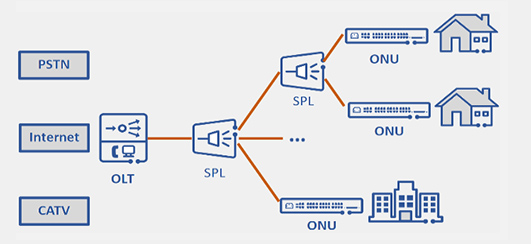
GPON system consists of the Optical Line Terminal (OLT), Optical Network Unit (ONU), and Optical Distribution Network (ODN). Generally, OLTs are placed in a CO equipment room and mainly used to converge optical signals from ONUs. Depending on the access scenario, ONUs can be deployed in corridors and street sides to provide various access interfaces, such as POTS interfaces for telephone services and GE/FE interfaces for Internet access services. An ODN is composed of passive optical components such as optical fibers and one or more passive optical splitters. An ODN provides an optical communication channel between OLTs and ONUs.
· OLTs are service-side nodes of the access network, and are connected to service node devices through service node interfaces (SNIs) to enable service access.
· ONUs are user-side access devices which access customer premises equipment (CPE) through user-to-network interfaces (UNI).
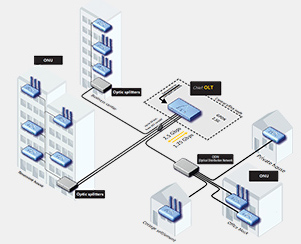
OLT is a core component of an optical access network. It is equivalent to the L2 switch or L3 router in a traditional communication network and functions as a multi-service platform. On one hand, it converges signals that carry various services at the CO side, sends the signals to the access network in a certain format, and transmits the signals to subscribers. On the other hand, it sent the signals received from subscribers to various service networks based on service types. OLT can connect multiple ONUs through optical splitters to control, manage, and range ONUs. OLT like a commander in chief, instructs each ONU to provide users with cost-effective and high-speed communication services, connecting users closely together through light signals. The OLT consists of the core layer, service layer, and common layer.
· Core layer: Provides aggregation, distribution, service processing, and ODN adaptation functions.
· Service layer: Provides service interfaces to support various services.
· Common layer: Provides power supply and maintenance functions.
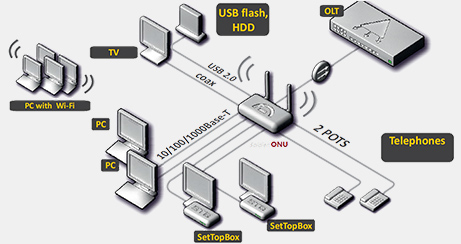
An ONU is located at the subscriber side and works with the OLT to implement layer 2 and layer 3 Ethernet functions and provide voice, data, and multimedia services for subscribers.The ONU implements the following functions:
· Filters and accepts data sent from the OLT.
· Responds to management instructions from the OLT and makes adjustments accordingly.
· Buffers the Ethernet data from subscribers and transmits the data upstream in transmit windows allocated by the OLT.
· Implements other subscriber management functions .
ONU device includes Multi-Dwelling Unit (MDU) and Optical Network Terminal (ONT), MDUs are usually be deployed in corridors and street sides cabinets, etc., ONTs are usually be deployed in user’s home
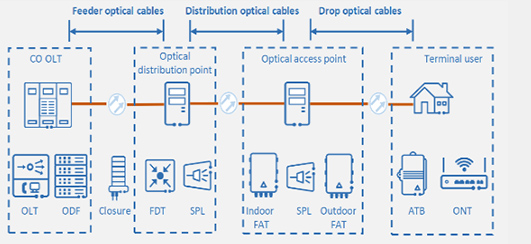
ODN is an optical cable network consisting of PON devices. It establishes an optical information transmission channel to transmit and distribute data between the OLT and ONUs.ODN can be divided by 2 points into 3 sections from the CO to the subscriber side. The 2 points refer to the optical distribution point and the optical access point. The 3 sections refer to feeder optical cables, distribution optical cables, and optical drop cables.
· FDT: Fiber Distribution Terminal
· FAT: Fiber Access Terminal
· ATB: Access Terminal Bo
· SPL: Optical splitter
Networking Applications
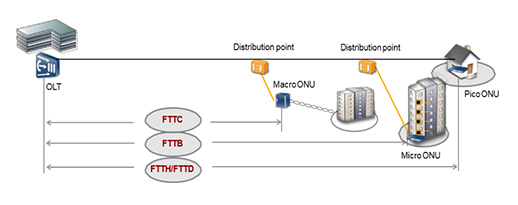
The GPON technology applies on FTTB, FTTC, FTTD, and FTTH networks based on access nodes.

The GPON technology applies on FTTB, FTTC, FTTD, FTTH, FTTO, and FTTW networks based on service scenarios.
Multi-Scenario
· @Home
· @Move
· @Work
Multi-Mode
· FTTH, FTTC, FTTB
· FTTDp
· FTTW and FTTO
Multi-Medium
· Copper, optical fiber, coaxial cable, and electric power cable
· Wi-Fi and small cell




